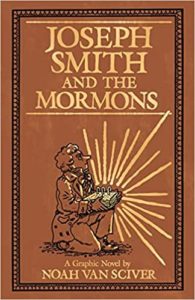Review
———
Title: Joseph Smith and the Mormons
Author/Illustrator: Noah Van Sciver
Publisher: Abrams ComicArts
Genre: Graphic Novel/Biography
Year Published: 2022
Number of Pages: 456
Binding: Hardcover
ISBN: 978-1419749650
Price: $29.99
Reviewed by Conor Hilton for the Association for Mormon Letters
Noah Van Sciver’s Joseph Smith and the Mormons is a stunning achievement. Van Sciver presents the entire history of Joseph Smith in this book (which he initially planned on only being 250 pages—thankfully, he let the book blossom to its 450 some-odd pages). Van Sciver’s book doesn’t contain new revelations about Joseph Smith or use never-before-read documents to craft its narrative, but it is a portrayal of Brother Joseph deeply rooted in a fascination with and empathy for him. The book will likely have something for and something to frustrate most readers that bring their own view of Smith to the book.
Since the book is a graphic novel, Van Sciver had a series of different choices and options available to him than most biographers of Smith. Van Sciver consistently makes interesting and compelling choices given the medium that he’s working in. I’ll only speak to a few of them and how they seem to reflect on the perspective and themes of the book overall.
First, Joseph Smith and the Mormons is told without captions. That is, everything we see and read is conveyed through dialogue (with the exception of occasional time and place markers that tell us where and when we are). Doing this grounds the story in the lives and conversations of the people involved. It would almost certainly be easier to tell some portions of the story with captions, but Van Sciver is committed to his choice and it pays off. Van Sciver includes a fairly robust selected bibliography, notes about some sections and potentially controversial topics, and specific sources for some of the quotes used in the back of the book. As a more academically minded person, I’d have loved at least some of that information to be brought into the main body of the book as footnotes, but at the same time I recognize that to do so would have heavily interfered with the artistic goals and vision of the book.
Second, Van Sciver rooted his decision on how to portray supernatural events in his commitment to telling the story through dialogue. Supernatural events are either not directly depicted or ambiguous in the main narrative of the text. Instead, they are almost always conveyed to the reader through dialogue as a memory. These scenes are presented in blue and white, to distinguish them from the main narrative. Initially, I found this a little off-putting—I want my Joseph Smith biographies & similar narratives to lean into the mystical, supernatural, transcendent, etc., and present them as unambiguously real! It seemed to me that presenting those events in a distinctive visual style was marking them as other and likely with suspicion. However, as I continued my way through the book, Van Sciver makes a few choices that shook that initial evaluation. I came to really value Van Sciver’s approach, which now strikes me as presenting these supernatural events the way that most of Brother Joseph’s contemporaries would have encountered them—from the mouth of someone else. In this way, we can occupy the place of one of the titular ‘Mormons’, hearing these events described by people that experienced and seem to maintain a belief in them, even while they are somewhat beyond our own experience.
Third, the art itself! The art is often delightful, with a somewhat playful sensibility, while also maintaining a sort of melancholy about it, that seems fitting for the tragedy woven throughout and the tragic conclusion we’re moving towards. The way Joseph is depicted in particular is quite fascinating—I found myself vacillating between suspicion, admiration, frustration, and disappointment. But with empathy and fascination as a constant foundation. Though with a less complicated empathy for Emma Smith throughout, which certainly contributed to the complicated feelings I felt towards Joseph. I am eager to read and hear other readers’ reactions to the visual depiction of Joseph to see if my response is common.
Most of the book is composed of pages with two columns of four panels each, but Van Sciver periodically breaks that standard template for larger panels, even incorporating some often stunning full-page images. The scenes of Haun’s Mill and the martyrdom are fittingly haunting, with earlier moments of beauty and quiet solitude receiving the full-page treatment.
Joseph Smith and the Mormons is a must-read for those interested in Mormon comics and a fascinating contribution to the narratives of Joseph Smith. Van Sciver doesn’t shy away from the complicated and difficult and harrowing parts of Joseph Smith’s life and the story of the early Mormons, but he sees his subjects as deeply human and never fails to grant them that humanity.

